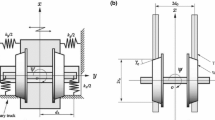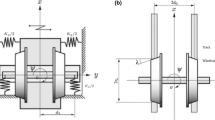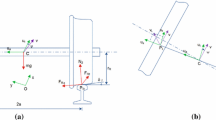Abstract
The China high speed railway vehicles of type CRH2 and type CRH3, modeled on Japanese high speed Electric Multiple Units (EMU) E2 series and Euro high speed EMU ICE3 series possess different stability behaviors due to the different matching relations between bogie parameters and wheel profiles. It is known from the field tests and roller rig tests that, the former has a higher critical speed while large limit cycle oscillation appears if instability occurs, and the latter has lower critical speed while small limit cycle appears if instability occurs. The dynamic model of the vehicle system including a semi-carbody and a bogie is established in this paper. The bifurcation diagrams of the two types of high speed vehicles are extensively studied. By using the method of normal form of Hopf bifurcation, it is found that the subcritical and supercritical bifurcations exist in the two types of vehicle systems. The influence of parameter variation on the exported function Rec 1(0) in Hopf normal form is studied and numerical shooting method is also used for mutual verification. Furthermore, the bifurcation situation, subcritical or supercritical, is also discussed. The study shows that the sign of Re(λ) determinates the stability of linear system, and the sign of Rec 1(0) determines the property of Hopf bifurcation with Rec 1(0)>0 for supercritical and Rec 1(0)<0 for subcritical.
Similar content being viewed by others
References
Marshall D C F. A History of British Railways down to the Year 1830. London: Oxford University Press, 1938. 147–148
Vermeulen P J, Johnson K L. Contact of non-spherical bodies transmitting Tangential forces. J Appl Mech, 1964, 31: 338–340
Kalker J J. A fast algorithm for the simplified theory of rolling contact. Vehicle Styst Dyn, 1982, 11(1): 1–13
Shen Z Y, Hedrick J K, Elkins J A. A comparison of alternative creep force models for rail vehicle dynamic analysis. Proceeding of the 8th IAVSD on Dynamics of Vehicles on Roads and Tracks. Cambridge: Swets and Zeitlinger, 1984. 591–605
Wickens A H. The dynamic stability of railway vehicle wheelsets and bogies having Profiled wheels. Int J Solids Sturct. 1965, 1(3): 319–341
Knudsen C, Feldberg R, Jaschinski A. Nonlinear dynamic phenomena in the behavior of a railway wheelset model. Nonlinear Dynam, 1991, 2: 389–404
Kass-Petersen C, True H. Periodic, bi-periodic and chaotic dynarnical behaviour of railway vehicles. Proceedings of the 9th IAVSD Symposium, vol 15. Linköping: Linköping University. 1986. 208–221
Kass-Petersen C. Chaos in a railway bogie. Acta Mech, 1986, 61: 89–107
True H. Dynamics of a rolling wheelset. Appl Mech Rev, 1993, 46: 438–444
True H. Kass-Petersen C. A bifurcation analysis of nonlinear oscillations in railway vehicle. Vehicle Styst Dyn, 1983, 12: 5–6.
True H, Kass-Petersen C. A bifurcation analysis of nonlinear oscillations in railway vehicles. Proceedings of the 8th IAVSD Symposium, vol 13. Cambridge: Swets and Zeitlinger, 1984. 655–665
True H. Railway vehicle chaos and asymmetric hunting. Vehicle Styst Dyn, 1983, 6: 225–637.
Zboinski K, Dusza M. Self-exciting vibrations and Hopf’s bifurcation in non-linear stability analysis of rail vehicles in a curved track. Eur J Mech A-Solid, 2010, 29: 190–203
Zeng J. Numerical computations of the hunting bifurcation and limit cycles for railway vehicle system (in Chinese), J Chin Railway Society, 1996, 18(3): 13–19
Lv K W. Study on the nonlinear dynamic problems for railway vehicle systems (in Chinese). PhD Thesis. Chengdu: Southwest Jiaotong University, 2004
Huigol R R, Janus R, Lohe M A, et al. On the application of a numerical algorithm for Hopf bifurcation to the hunting of a wheelset. J Austral Math Soc Ser B, 9184, 25: 384–405
Ahmadian M, Yang S P. Effect of system nonlinearities on locomotive bogie hunting stability. Vehicle Styst Dyn, 1998, 29: 365–384
Ahmadian M, Yang S P. Hopf bifurcation and hunting behavior in a rail wheelset with flange contact. Nonlinear Dynam, 1998, 15: 15–30
True H, Thomsen P. On the problems of non-smooth railway vehicle dynamics—Multibody dynamics. ECCOMAS Thematic Conference, 2005
True H. On the theory of nonlinear dynamics and its applications in vehicle systems dynamics. Vehicle Styst Dyn, 1999, 31: 393421
True H. Typical non-smooth elements in vehicle systems, non-smooth problems in vehicle system dynamics. Proceedings of the Euromech 500 Colloquium, Berlin, 2010. 3–15
Suda Y. High speed stability and curving performance of longitudinally unsymmetric trucks with semi-active control. Vehicle Syst Dyn, 1994, 23: 29–52
Lee S-Y, Cheng Y-C. Hunting stability analysis of highspeed railway vehicle trucks on tangent tracks. J Sound Vib, 2005, 282(3–5): 881–898
Lee S-Y, Cheng Y-C. Nonlinear analysis on hunting stability for high-speed railway vehicle trucks on curved tracks. Trans ASME J Vib Acoust, 2005, 127(4): 324–332
Zeng J, Wu P B. Stability analysis of high speed railway vehicles. JSME Int J Series C, 2004, 47(2): 464–470
Polach O. Comparability of the non-linear and linearized stability assessment during railway vehicle design. Vehicle Styst Dyn, 2006, 44(Supp): 129–138
Polach O. On non-linear methods of bogie stability assessment using computer simulations. P I Mech Eng F-J Rai, 2006, 220: 13–27
Chen R L, Zeng Q Y, Zhong X G, et al. Numerical study on the restriction speed of train passing curved rail in cross wind. Sci China Tech Sci, 2009, 52: 2037–2034
Traction Power State Key Laboratoryof China. Research on suspension multiparameter method of CRH2 and CRH3 based on hunting resonance theory (in Chinese). Traction Power State Key Laboratory Report, December, 2012
Froment O, Aubry D, Castel L. Analysis of the stability of nonlinear railway dynamics. Comput Mech, 1998, 1: 12–19
Gang V K, Dukkipati R V. Dynamics of Railway Vehicle Systems. Chengdu: Southwest Jiaotong University Press, 1997. 140–175
Zhai W M. Vehilce-rail Coupling Dynamics (in Chinese). Beijing: Science Press, 2007. 394
Zhang W H. Dynamic Simulation for Locomotive (in Chinese). Beijing: China Railway Press, 2006. 394
Wang F T. Vehicle System Dynamic (in Chinese). China Railway Press, 1994. 49–58
Gao X J, Li Y H, Yue Y. The “resultant bifurcation diagram” method and its application to bifurcation behaviors of a symmetric railway bogie system. Nonlinear Dynam, 2012, 70: 363–380
Leine R I, Nijmeijer H. Dynamics and Bifurcations of Non-smooth Mechanical Systems. Heidelberg: Springer, 2004. 5
von Wagner U. Nonlinear dynamic behavior of a railway wheelset. Vehicle Styst Dyn, 2009, 47(5): 627–640
Kuznetsov Y A. Elements of Applied Bifurcation Theory. 2nd ed. New York: Springer-Verlag, 1998. 91–99, 99, 175–178, 307–308
18.385j/2.036j.ppt MIT. Hopf Bifurcations. Department of Mathematics, Massachusetts Institute of Technology Cambridge, Massachusetts MA 02139
Hassard B D, Kazarinoff N D, Wan Y H. Theory and Application of Hopf Bifurcation. Cambridges: Cambridges University Press 1981. 14–52, 130
http://www.math.vt.edu/people/renardym/classhome/nova/bifs/node18.html
Author information
Authors and Affiliations
Corresponding author
Rights and permissions
About this article
Cite this article
Dong, H., Zeng, J., Xie, J. et al. Bifurcation\instability forms of high speed railway vehicles. Sci. China Technol. Sci. 56, 1685–1696 (2013). https://doi.org/10.1007/s11431-013-5254-x
Received:
Accepted:
Published:
Issue Date:
DOI: https://doi.org/10.1007/s11431-013-5254-x




